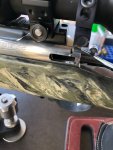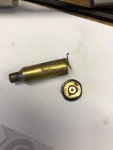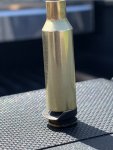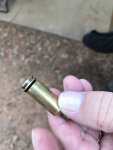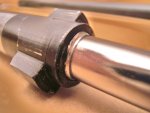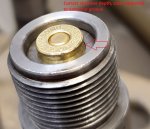Hey folks, I hesitate to post this since I'm sure I'm going to get all sorts of responses of what I did wrong, should have done, didn't do, how stupid, etc., etc., etc. but it's worth it to me to post as a cautionary tale for other reloaders.
I was shooting my 6 Creed yesterday. Load is 44.5 grains R23, CCI 200, 105 hybrid and Hornady cases. The cases have been reloaded less than five times and never been over-pressured. 44.5 grains is halfway up the shoulder in the case. I've run it to 46 grains which is a completely full case with zero pressure. The action is made by Defiance for Brownells and called Stryker Ridge. Powder came from an 8 lbs. container which I bought sealed and I've used over five pounds so far with no issues.
I loaded 50 rounds with the FX-120. Each charge is then dropped in the case with a funnel and I move on to the next case. There's no way to overcharge since the case is so full and I've filled the case completely with no pressure. Low charges are unlikely since I'd have to spill much of the powder and it would be obvious it wasn't fully charged. Missing a charge completely seems unlikely given resulting overpressure.
I shot 30 shots at 600 yards and on the 31st, BOOM! Extractor broken in half, extractor spring gone and the bolt stop somewhere on the range never to be found. I jump back, pull off the ears and glasses and stand dumbfounded. Then, I feel the blood coming down my face. I had powder/gas burns on my cheek and nose and couple little spots under my eyes. I was wearing reading glasses.
The bolt easily opens. The case is still in the chamber. After collecting myself I set the rifle aside and pick up my other rifle to finish group testing with a few loads. Gotta get back on the horse so to speak.
I get home and take the rifle apart. There's no obstruction in the suppressor or barrel. A cleaning rod pushed the case head out with no resistance. I chucked the barrel in the lathe expecting to have to work at getting the rest of the case from the chamber. To my surprise I was able to pull it out with my fingers. A bore scope shows nothing abnormal in the chamber or throat. The action body looks fine with the exception of the missing bolt stop. I remove the firing pin assembly and nothing odd there except the overpowering smell of burnt powder/gas. The firing pin itself shows no marks from gas and the firing ping hole looks the same, normal.
I still need to pull the rest of the bullets and weigh the charges to verify. After reviewing my loading procedure I can only think of two items as a cause barring finding undercharged cases.
1) Case head rupture - I've had case head failures in other hotrod rifles but those usually come apart after firing and retracting the case. Those cases are also pushed hard which these weren't. I don't think this is it but I'll be checking the remaining cases for incipient case head failures just to be sure.
2) Stainless steel media - I don't use it often but I do use it. After running cleaned cases in a media separator I blow out each case with an air compressor from the neck and primer pocket. It's possible one was still in the previous case and lodged in the barrel. The 'boom' shot could have dislodged the pin but still been way overpressure.
The case clearly came apart violently at the unsupported portion.
I was shooting my 6 Creed yesterday. Load is 44.5 grains R23, CCI 200, 105 hybrid and Hornady cases. The cases have been reloaded less than five times and never been over-pressured. 44.5 grains is halfway up the shoulder in the case. I've run it to 46 grains which is a completely full case with zero pressure. The action is made by Defiance for Brownells and called Stryker Ridge. Powder came from an 8 lbs. container which I bought sealed and I've used over five pounds so far with no issues.
I loaded 50 rounds with the FX-120. Each charge is then dropped in the case with a funnel and I move on to the next case. There's no way to overcharge since the case is so full and I've filled the case completely with no pressure. Low charges are unlikely since I'd have to spill much of the powder and it would be obvious it wasn't fully charged. Missing a charge completely seems unlikely given resulting overpressure.
I shot 30 shots at 600 yards and on the 31st, BOOM! Extractor broken in half, extractor spring gone and the bolt stop somewhere on the range never to be found. I jump back, pull off the ears and glasses and stand dumbfounded. Then, I feel the blood coming down my face. I had powder/gas burns on my cheek and nose and couple little spots under my eyes. I was wearing reading glasses.
The bolt easily opens. The case is still in the chamber. After collecting myself I set the rifle aside and pick up my other rifle to finish group testing with a few loads. Gotta get back on the horse so to speak.
I get home and take the rifle apart. There's no obstruction in the suppressor or barrel. A cleaning rod pushed the case head out with no resistance. I chucked the barrel in the lathe expecting to have to work at getting the rest of the case from the chamber. To my surprise I was able to pull it out with my fingers. A bore scope shows nothing abnormal in the chamber or throat. The action body looks fine with the exception of the missing bolt stop. I remove the firing pin assembly and nothing odd there except the overpowering smell of burnt powder/gas. The firing pin itself shows no marks from gas and the firing ping hole looks the same, normal.
I still need to pull the rest of the bullets and weigh the charges to verify. After reviewing my loading procedure I can only think of two items as a cause barring finding undercharged cases.
1) Case head rupture - I've had case head failures in other hotrod rifles but those usually come apart after firing and retracting the case. Those cases are also pushed hard which these weren't. I don't think this is it but I'll be checking the remaining cases for incipient case head failures just to be sure.
2) Stainless steel media - I don't use it often but I do use it. After running cleaned cases in a media separator I blow out each case with an air compressor from the neck and primer pocket. It's possible one was still in the previous case and lodged in the barrel. The 'boom' shot could have dislodged the pin but still been way overpressure.
The case clearly came apart violently at the unsupported portion.

